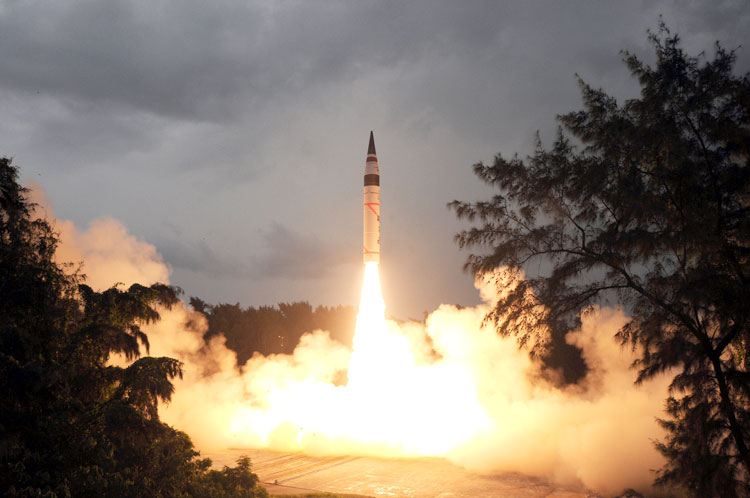Guest Column | Checks and Balances
 Lt Gen. B.S. Nagal (retd)
Lt Gen. B.S. Nagal (retd)
The only thing that is constant is change — Heraclitus
To improve is to change; to be perfect is to change often — Winston Churchill
Fifteen years ago India released its draft nuclear doctrine and 11 years ago, the Cabinet Committee on Security (CCS) released the final doctrine on 3 January 2003. The salient points in the CCS approval were: Credible Minimum Deterrent (CMD); No First Use Policy (NFU); Massive Retaliation (MR); Non-use of nuclear weapons against Non-Nuclear Weapon States (NNWS); and option of use of nuclear weapons in case of major attack by biological or chemical weapons.
Deterrence
The CCS release read in conjunction with the draft doctrine affirmed nuclear deterrence is related to ‘India’s strategic interests, deter use or threats of use of nuclear, chemical and biological weapons’, the requirements of deterrence would weigh in the design of the nuclear forces and the strategy on the level of capability.
One can also infer the great powers equation in the calculus. The nuclear doctrine did not cater for conventional deterrence or the lower side of the spectrum of war/violence, on the other hand conventional deterrence was expected to raise the threshold for nuclear war. In the draft doctrine paragraph 2.7 stated ‘highly effective conventional military capabilities shall be maintained to raise the threshold of outbreak, both of conventional military conflict as well as that of threat or use of nuclear weapons’.
Therefore, India’s nuclear deterrence is clearly strategic in nature, and is linked to the four aspects stated above i.e. nuclear, biological, chemical and strategic interests. There are many quarters where the effectiveness of our nuclear deterrent vis-à-vis proxy war is questioned. The issue of proxy war is not linked to nuclear doctrine. Conventional deterrence must counter the proxy war and terrorism. The objectives of the US and UK nuclear policy are also similar, i.e. to deter nuclear, biological or chemical threats or protect vital interests or prevent blackmail/coercion.
There is a school of thought in India that the country should adopt a strategy of nuclear war-fighting, based on our neighbours’ developing tactical nuclear weapons (TNW) and adopt a quid pro quo option instead of massive retaliation. At present, there is no common definition of TNW, the general understanding is that the weapon is of low yield, delivered by short range artillery or short range missile or aircraft for use in the battlefield area and could include forward airfields.
Therefore, the use of TNW will be limited to army field formations and logistics echelons or bases in support of offensive formations in the battle zone, forward aviation assets, forward air bases, critical command and control centres. It can be a link between conventional war and strategic nuclear exchange. In western parlance air delivered weapons not part of the strategic delivery systems of bigger yields are called non-strategic weapons. This, however, does not apply in the South Asia context.
The proponents of TNW bring out that this strategy is suited to overcome conventional inferiority by linking conventional war to nuclear at an early stage. TNW destroy ingressing conventional forces and stabilise the battlefield by defeating offensives, hence may help de-escalate a conflict. The weapons are very effective on point targets e.g. airfields, bridges, missile sites, choke points and lines of communication. As such, a nuclear war-fighting strategy is an option with countries with weaker/ inferior conventional forces.

The opponents of TNW highlight problems in adopting a nuclear war-fighting strategy. First, it proliferates nuclear weapons down to battlefield level, resulting in greater and faster demand for use of nuclear weapons. Second, at some point of time in the war, sooner than later, authority will be delegated to lower levels in the military, thus resulting in a lowered threshold. Third, escalation control cannot be imposed in a TNW, resulting in a spiral leading to strategic nuclear exchange. Fourth, large scale use of TNW will result in high radiation in populated areas and winds will spread this radiation to large tracts. TNWs result in an arms race and are inherently destabilising. Based on the arguments above it is not recommended as a strategy for India.
India will follow a strategy of strategic nuclear deterrence is clear from the overall doctrine, and has not indicated interest in nuclear war-fighting (the absence of development of delivery systems for TNW). It views nuclear weapons not for use but deterrence. If deterrence fails, only then use them as a last option. The strategic deterrence strategy is not destabilising and does not result in an arms race or battlefield use of nuclear weapons.
Considering the reasons and rationale for India’s strategic nuclear deterrence, it is in sync and consonance with world opinion, thought and logic and more importantly meets India’s requirements in the rapidly changing world power calculus, therefore does not require any change or modification. Overall, it can be said that our nuclear deterrence and strategic policy have worked effectively.
Credible Minimum Deterrent
India has two neighbours with nuclear weapons and both are in concert with each other on politico-military issues, thereby aggravating India’s security concerns. The capability being developed by one is far beyond their deterrence requirements. The four plutonium producing reactors and a uranium facility will allow building of a very large arsenal. The fissile material held by the other, too, is a matter of concern, especially coupled with the multiple delivery means available/ under development.
The first issue in the CCS approval of the nuclear doctrine was ‘Credible Minimum Deterrent’. The draft doctrine stated that it is a dynamic concept related to strategic environment, technological imperatives and the needs of national security. The Credible Minimum Deterrent, therefore, is a dynamic concept and caters to emerging and existing threats, it is not minimum in size as defined in western literature and provides planners the flexibility, space and scope to adjust to the strategic environment and national security needs, and we build our deterrent accordingly.
Today, with a policy of No First Use and Massive Retaliation, the concept of CMD must factor in ‘survivability and sufficient numbers’ that can inflict unacceptable damage. Adversary arsenal size, technological advances, defensive and offensive forces, protection and C4ISR are factors for considerations whilst arriving at the size, delivery means and yield of the deterrent. Development of nuclear capability being a lengthy process, it is prudent to plan on the positive side (except on a scale which may cause an arms race) while building capacities and strategic forces.
India correctly chose CMD in 2003, when only blurred contours of one adversary existed and little was known of the other adversary, events since then have validated the concept and provides India the necessary flexibility.
No First Use
The second aspect of the doctrine is No First Use (NFU). The advantages of this policy are that NFU is a defensive policy and reassuring globally that India is not an aggressive power. A NFU policy is good for crisis stability especially in a volatile geopolitical region. With NFU policy, India will always take a moral high ground whilst seeking nuclear disarmament or a nuclear weapons free world.
NFU can be a good policy when the weapon equation is very skewed e.g. China vs India in 1998 or US vs China in the Sixties, the weaker nation has no capability to challenge/cause any damage to the dominant power. It may also be a viable policy when the first use adversary has a very small arsenal and would not cause much damage, and the NFU state could absorb the nuclear strikes and then retaliate. The policy also prevents accidental exchange of nuclear strikes as weapons are not on hair trigger alert. NFU ensures better safety and security since it avoids deployment of nuclear weapons.
Confidence Building Measures (CBMs) can be worked better to reduce the chance of a nuclear exchange with a NFU policy. In India’s case, avoiding of economic sanctions by placating upset powers may have been a reason but probably was not because by 2003 the worst on the
Subscribe To Force
Fuel Fearless Journalism with Your Yearly Subscription
SUBSCRIBE NOW
We don’t tell you how to do your job…
But we put the environment in which you do your job in perspective, so that when you step out you do so with the complete picture.








